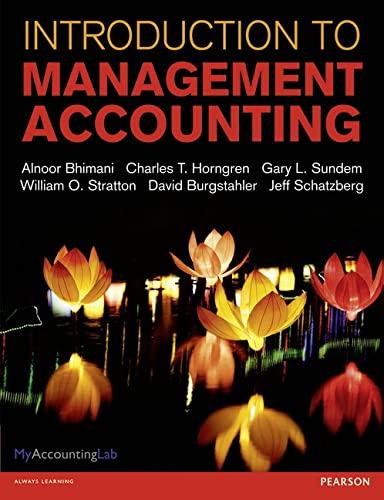The Garcia Manufacturing Company has two producing departments, machining and assembly. Mr Garcia recently automated the machining
Question:
The Garcia Manufacturing Company has two producing departments, machining and assembly.
Mr Garcia recently automated the machining department. The installation of a CAM system, together with robotic workstations, drastically reduced the amount of direct labour required. Meanwhile, the assembly department remained labour intensive. The company had always used one firm-wide rate based on direct-labour hours as the cost-allocation base for applying all costs (except direct materials) to the final products. Mr Garcia was considering two alternatives:
(1). Continue using direct-labour hours as the only cost-allocation base, but use different rates in machining and assembly, and
(2). Using machine hours as the cost allocation base in the machining department while continuing with direct-labour hours in assembly. Budgeted data for 20X0 are as follows:

1. Suppose Garcia continued to use one firm-wide rate based on direct-labour hours to apply all manufacturing costs (except direct materials) to the final products. Compute the cost application rate that would be used.
2. Suppose Garcia continued to use direct-labour hours as the only cost-allocation base but used different rates in machining and assembly.
(a). Compute the cost-application rate for machining.
(b). Compute the cost-application rate for assembly.
3. Suppose Garcia changed the cost accounting system to use machine hours as the cost allocation base in machining and direct-labour hours in assembly.
(a). Compute the cost-application rate for machining.
(b). Compute the cost-application rate for assembly.
4 Three products use the following machine hours and direct-labour hours:

(a). Compute the manufacturing cost of each product (excluding direct materials) using one firm-wide rate based on direct-labour hours.
(b). Compute the manufacturing cost of each product (excluding direct materials) using direct-labour hours as the cost-allocation base, but with different cost-allocation rates in machining and assembly.
(c). Compute the manufacturing cost of each product (excluding direct materials) using a cost-allocation rate based on direct-labour hours in assembly and machine hours in machining.
(d). Compare and explain the results in requirements 4a, 4b and 4c.
Step by Step Answer:

Introduction To Management Accounting
ISBN: 9780273737551
1st Edition
Authors: Alnoor Bhimani, Charles T. Horngren, Gary L. Sundem, William O. Stratton, Jeff Schatzberg





